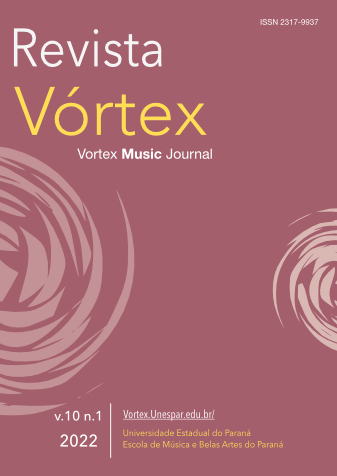Schaeffer's Solfège, Percussion, Audio Descriptors: Towards an Interactive Musical System
DOI:
https://doi.org/10.33871/23179937.2022.10.1.5Palabras clave:
Schaeffer's Solfège, Percussion, Audio Descriptors, Interactive SystemsResumen
Pierre Schaeffer's typomorphology (1966) proposes seven criteria of musical perception for the identification and qualification of sound objects, which form the basis of his musical theory. This Solfège fits well into contexts where pitch is not the dominant dimension. Relying on similarities between the practice of reduced listening and the utilization of low-level audio descriptors, we present the first version of a real-time setup in which these descriptors are applied to qualify percussive sounds. The paper describes the tools and strategies used for addressing different criteria: envelope followers with different window sizes and filtering; detection of transients and amplitude modulations; extraction and counting of spectral components; estimation of intrinsic dissonance and spectral distribution; among others. The extracted data is subjected to simple statistical analysis, producing scalar values associated with each segmented object. Finally, we present a variety of examples.Descargas
Citas
BERNARDES, G.; DAVIES, M.; GUEDES, C. A Pure Data Spectro-Morphological Analysis Toolkit for Sound-Based Composition. In: EAW2015 - INTERNATIONAL CONGRESS FOR ELECTROACOUSTIC MUSIC - ELECTROACOUSTIC WINDS 2015, 2015, Aveiro. Proceedings... Aveiro: Proceedings of the eaw2015, 2015. p. 31–38.
CHION, Michel. Guide des Objets Sonores. Paris: Buchet/Chastel, 1983.
DI SCIPIO, Agostino. The Politics of Sound and the Biopolitics of Music: Weaving Together Sound-Making, Irreducible Listening, and the Physical and Cultural Environment. Organised Sound, v. 20, n. 3, p. 278–289, dec. 2015.
GIESELER, W.; LOMBARDI, L.; WEYER, R. Instrumentation in der Musik des 20. Jahrhunderts: Akustik, Instrumente, Zusammenwirken. Celle: Moeck Verlag, 1985.
GODØY, Rolf Inge. Perceiving Sound Objects in the Musique Concrète. Frontiers in Psychology, v. 12, 2021. Available at: <https://www.frontiersin.org/articles/10.3389/fpsyg.2021.672949/full>. Access: 7 jun. 2021.
HELLER, Eric Johnson. Why you hear what you hear: an experiential approach to sound, music, and psychoacoustics. 2013.
PEETERS, G. et al. The Timbre Toolbox: Extracting Audio Descriptors from Musical Signals. The Journal of the Acoustical Society of America, v. 130, n. 5, p. 2902–2916, nov. 2011.
PEETERS, Geoffroy; DERUTY, Emmanuel. Sound Indexing Using Morphological Description. IEEE Transactions on Audio, Speech, and Language Processing, v. 18, n. 3, p. 675–687, mar. 2010.
PUCKETTE, Miller S; APEL, Theodore; ZICARELLI, David D. Real-time Audio Analysis Tools for Pd and MSP. In: INTERNATIONAL COMPUTER MUSIC CONFERENCE, 1998, San Francisco. Proceedings... San Francisco, 1998. p. 109–112.
RICARD, Julien. Towards Computational Morphological Description of Sound. 2004. Doctorate – Universitat Pompeu Fabra, Barcelona, 2004.
ROWE, Robert. Interactive music systems: machine listening and composing. Cambridge: MIT press, 1993. Available at: <http://dl.acm.org/citation.cfm?id=530519>. Access: 16 jun. 2014.
SCHAEFFER, Pierre. Traité des Objets Musicaux. Paris: Éditions du Seuil, 1966.
SCHAEFFER, Pierre. Treatise on Musical Objects: Essays Across Disciplines. Translated by Christine North; John Dack. Oakland, California: University of California Press, 2017.
SERRA, Xavier; SMITH, Julius. Spectral Modeling Synthesis: A Sound Analysis/Synthesis System Based on a Deterministic Plus Stochastic Decomposition. Computer Music Journal, v. 14, n. 4, p. 12–24, 1990.
SETHARES, William A. Tuning, Timbre, Spectrum, Scale. London: Springer, 2005. Available at: <http://public.eblib.com/EBLPublic/PublicView.do?ptiID=303730>. Access: 15 may. 2013.
SODDELL, Thembi. The Acousmatic Gap as a Flexile Path to Self-Understanding: A case for experiential listening. Organised Sound, v. 25, n. 3, p. 344–352, dec. 2020.
SOLOMON, Samuel Z. How to Write for Percussion: a Comprehensive Guide to Percussion Composition. 2nd. ed. New York: Oxford University Press, 2016.
VALLE, Andrea. Schaeffer Reconsidered: a Typological Space and its Analytical Applications. Analitica, v. 8, n. 1, p. 1–15, 2015.
Descargas
Publicado
Cómo citar
Número
Sección
Licencia
Derechos de autor 2022 Sérgio Freire, José Henrique Padovani, Caio Costa Campos

Esta obra está bajo una licencia internacional Creative Commons Atribución 4.0.
Los autores conservan los derechos de autor y conceden a la revista el derecho de primera publicación, con el trabajo simultáneamente bajo la licencia Creative Commons Attribution Licence que permite compartir el trabajo con reconocimiento de autoría y publicación inicial en esta revista.






